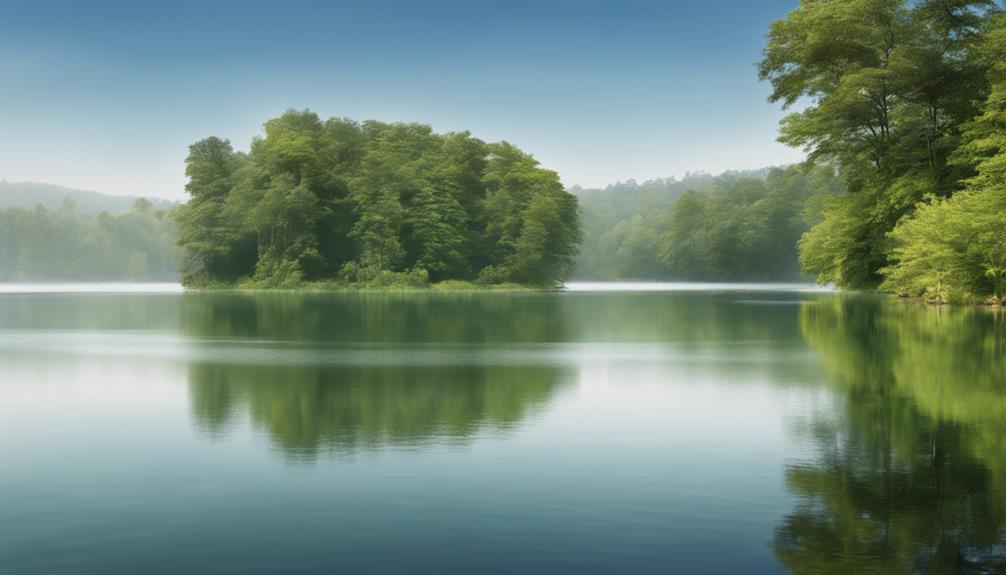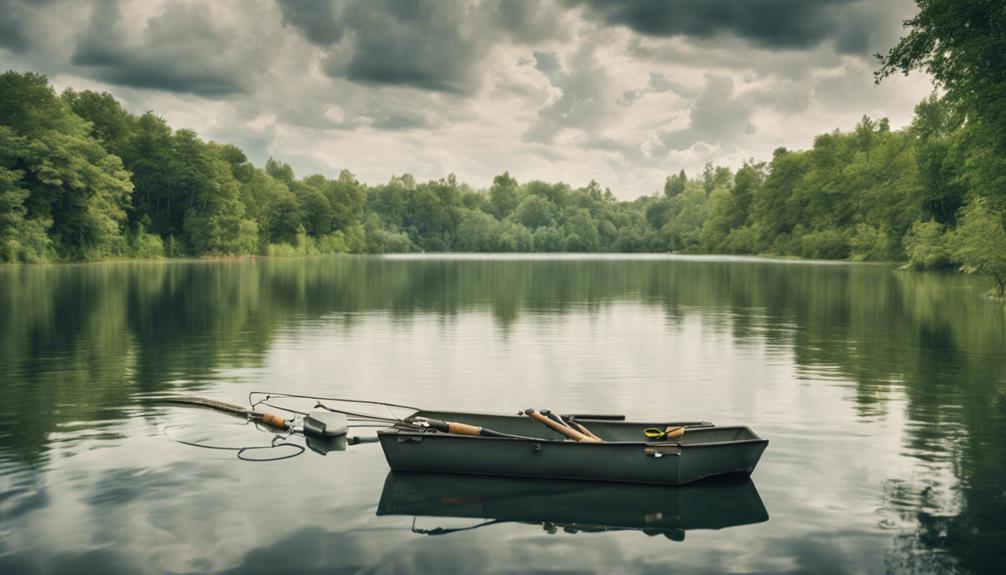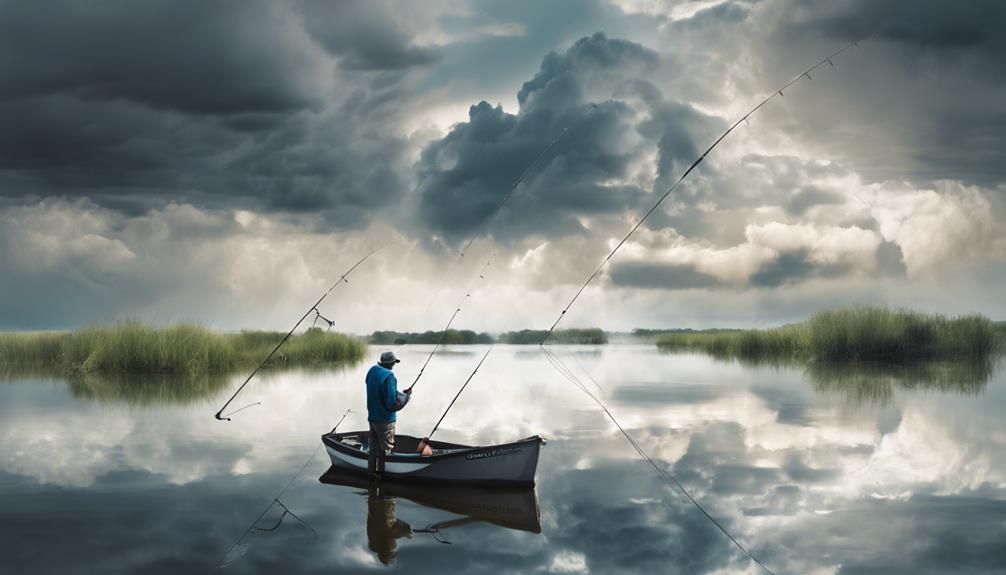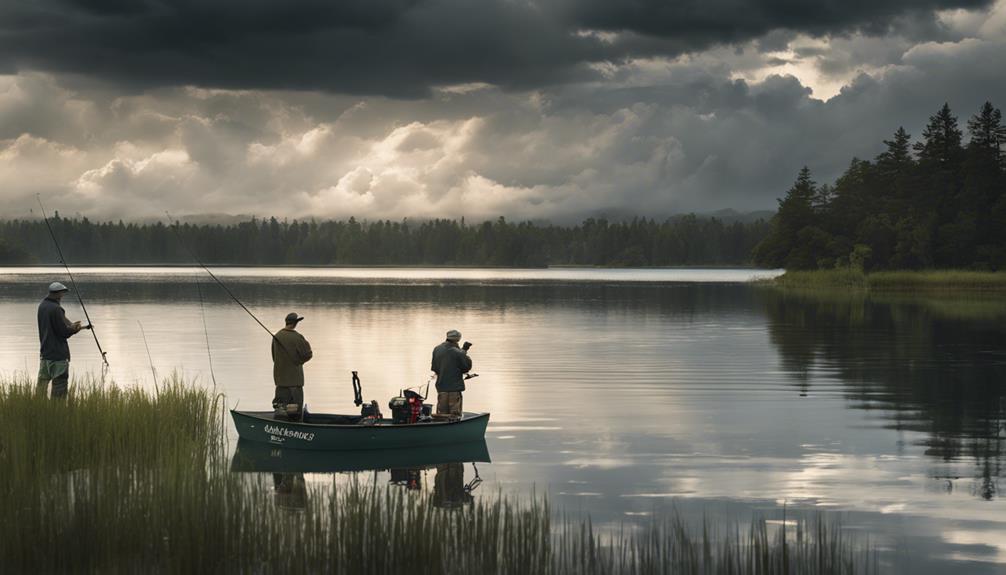To optimize your deep lake fishing experience, aim for water temperatures ranging between 50°F and 70°F. This range boosts fish activity levels and enhances visibility. Keep an eye on wind speeds of 5 to 15 mph, as they stimulate fish and aid in attracting baitfish to the shoreline. Additionally, look for cloud cover to reduce sunlight penetration, altering fish behavior subtly. Understanding these critical factors can significantly impact your catch rates. Mastering the nuances of temperature, wind, and cloud cover will elevate your fishing game to new levels, helping you reel in more prized catches.
Optimal Temperature Range
To optimize your deep lake fishing experience, aim for water temperatures between 50°F and 70°F for increased fish activity. Water clarity plays a crucial role in fish visibility, affecting their ability to spot bait and lures. In clearer waters, fish can see more clearly and are more likely to be attracted to your offerings.
Additionally, oxygen levels in the water directly impact fish activity. Warmer water temperatures, within the recommended range, generally result in higher oxygen levels, promoting increased fish metabolism and movement. Fish tend to be more active in oxygen-rich environments, making them more responsive to your fishing tactics.
When water temperatures exceed 70°F, fish may become lethargic as oxygen levels decrease. This decrease in oxygen can lead to fish moving to deeper, cooler waters, making it harder for anglers to reach them effectively. On the other hand, water temperatures below 50°F might slow down fish metabolism, causing them to be less active and less inclined to feed.
Therefore, by targeting water temperatures between 50°F and 70°F, you can maximize your chances of a successful deep lake fishing trip. Keep an eye on water clarity and oxygen levels to gauge fish visibility and activity, allowing you to adjust your fishing techniques accordingly for a more fruitful outing.
Ideal Wind Conditions
Optimal wind conditions play a crucial role in deep lake fishing success, influencing fish behavior and angler strategy. When considering wind speed, moderate winds ranging from 5 to 15 miles per hour are ideal for deep lake fishing. These winds help create natural currents in the water, stimulating fish activity and feeding behavior. However, wind speeds exceeding 15 miles per hour can make it challenging to control the boat and maintain bait presentation, leading to a decrease in fishing efficiency.
In terms of wind direction, a steady wind blowing parallel to the shoreline is highly favorable for deep lake fishing. This type of wind direction pushes baitfish closer to the shore, attracting predator fish to feed in shallower waters. Anglers can take advantage of this natural phenomenon by positioning their boats strategically along the shorelines to target active fish. Conversely, winds blowing directly across the lake can create choppy waters and disrupt the feeding patterns of fish, making it harder to locate and catch them.
To optimize your deep lake fishing experience, pay close attention to wind speed and direction before heading out on the water. By choosing days with moderate winds and favorable wind direction, you can significantly increase your chances of a successful fishing trip.
Importance of Cloud Cover
Cloud cover significantly impacts deep lake fishing conditions, affecting both fish behavior and angler success. When assessing the impact of cloud cover on fishing, it's essential to consider its influence on sunlight intensity and precipitation levels. Cloud cover acts as a natural filter for sunlight, reducing the amount of light that penetrates the water. This decrease in sunlight intensity can lead to changes in fish behavior. Some species may become more active and move to shallower areas in search of food, while others may retreat to deeper, darker waters.
Moreover, cloud cover plays a crucial role in regulating precipitation levels. Different fish species react differently to changes in water clarity caused by rain. For example, some fish are more likely to feed aggressively after a rainstorm, while others may become less active. Anglers should be aware of these behavioral patterns and adjust their fishing techniques accordingly.
Frequently Asked Questions
Can the Time of Day Impact Deep Lake Fishing Success?
Daytime vs. nighttime fishing can greatly impact deep lake fishing success. Fish behavior varies depending on the time of day.
Weather changes also play a crucial role in fishing outcomes. Factors such as temperature, barometric pressure, and cloud cover can affect fish activity levels.
How Does Water Clarity Affect Fishing in Deep Lakes?
Water clarity significantly impacts fishing success in deep lakes. It plays a crucial role in temperature regulation and light penetration, influencing fish behavior and feeding patterns.
Clear water allows sunlight to penetrate deeper, affecting the distribution of fish. It also influences water temperature variations, impacting where fish congregate.
Understanding how water clarity affects these factors is essential for successful deep lake fishing trips.
Are There Specific Fish Species That Prefer Certain Weather Conditions?
Fish behavior can be influenced by weather patterns, with certain species showing preferences for specific conditions.
For example, bass are known to be more active during overcast days, while trout tend to feed more aggressively when it's raining.
Understanding these correlations between fish behavior and weather can help you anticipate which species are more likely to bite based on the prevailing conditions.
What Safety Precautions Should Be Taken During Deep Lake Fishing?
When engaging in deep lake fishing, ensure your safety by wearing appropriate safety gear like life jackets, first aid kits, and communication devices. Develop an emergency plan that includes informing someone of your location and expected return time.
Be prepared for changing weather conditions by dressing in layers and carrying extra clothing. Prioritize safety above all else to enjoy your fishing experience without any unwanted incidents.
Does Moon Phase Affect Fish Behavior in Deep Lakes?
Moon phase can impact fish behavior in deep lakes. Different moon phases can influence feeding patterns and activity levels of fish.
During the full moon, fish might be more active and feeding closer to the surface. Conversely, during a new moon, fish may retreat to deeper waters.
Understanding these lunar cycles can help you strategize your deep lake fishing trips for optimal success.
Conclusion
In conclusion, when deep lake fishing, it's essential to consider the ideal weather conditions for a successful outing.
By focusing on the optimal temperature range, favorable wind conditions, and the importance of cloud cover, anglers can increase their chances of catching more fish.
Remember to monitor weather forecasts closely and plan your fishing trips accordingly to maximize your chances of a productive and enjoyable fishing experience.



